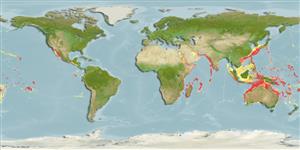Common names from other countries
Environment: milieu / climate zone / depth range / distribution range
экология
; солоноватоводный; пределы глубины 1 - 701 m (Ref. 96667). Tropical
Indo-Pacific: from Red Sea to Japan and Hawaii.
Length at first maturity / Size / Вес / Возраст
Maturity: Lm ? range ? - ? cm Max length : 6.7 cm TL (female)
Found on muddy sand with sponges, red mud, coarse muddy shell sand to sand with fragments of coralline algae (Ref. 80410). Species can be found in estuarine or brackish waters, from intertidal to subtidal areas (Ref. 106854).
Life cycle and mating behavior
половая зрелость | размножение | нерест | икра | Fecundity | личинки
Some members of the order Stomatopoda pair for life and some come together only to mate. Males produce sperm ducts rather than spermatophores; females can brood a maximum of 50,000 eggs. Life cycle: Eggs hatch to a planktonic zoea which lasts for 3 months.
Основная ссылка
ссылки | координатор | соавторы
Ahyong, S.T. 2001. (Ref. 3099)
Статус Красного Списка МСОП (Ref. 130435)
Статус СИТЕС (Ref. 108899)
Not Evaluated
Not Evaluated
Угроза для людей
Harmless
Использование человеком
| FishSource |
инструменты
дополнительная информация
Возраст/РазмерыростЗависимость между длиной и массой телаЗависимость между длинамиморфологияличинкичисленность
ресурсы в Интернет
Estimates based on models
Preferred temperature
(Ref.
115969): 11.7 - 26.5, mean 18.6 (based on 573 cells).
